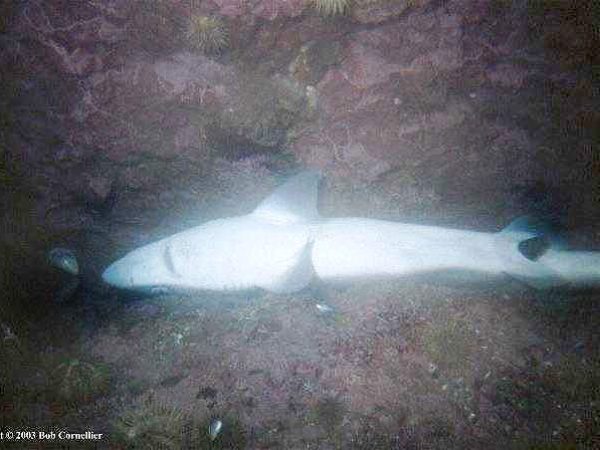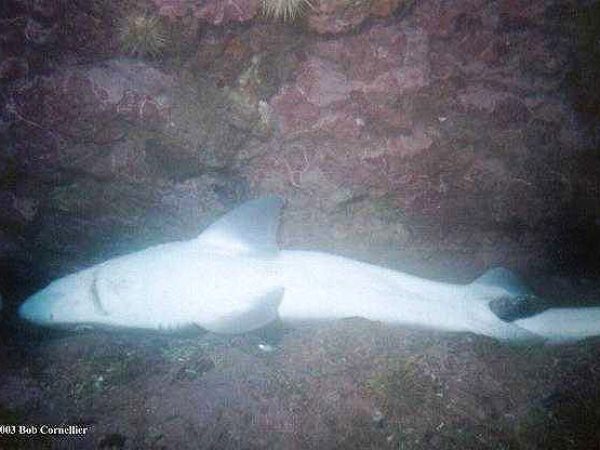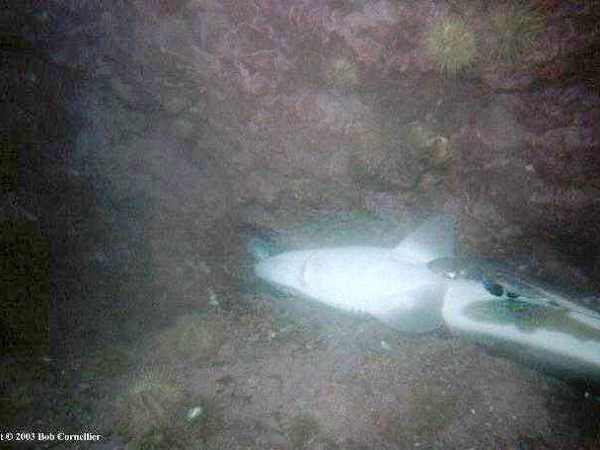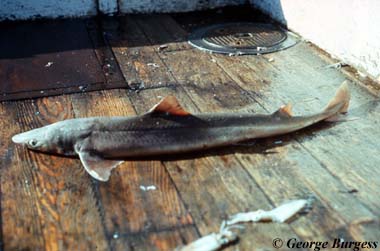
Squalus acanthias
This long, slender dogfish has a pointed snout, large eyes, and spines in front of its two dorsal fins. It is a brownish slate color, fading to a pale underbelly, with rows of white spots down its upper body that fade with age. These migratory, schooling sharks spend winters in deeper water where they possibly don’t eat much, and summer in coastal warm waters where they eat bony fish, smaller sharks, and many other sea animals. They rarely grow longer than 39 inches except in the cases of older females which have been caught up to 49 inches long.
Order: Squaliformes
Family: Squalidae
Genus: Squalus
Species: acanthias
Common Names
English language common names include spiny dogfish, blue dog, common spinyfish, darwen salmon, dogfish, grayfish, Pacific dogfish, piked dogfish, rock salmon, spiky dog, spotted spiny dogfish, spring dogfish, spur dogfish, spur dog, victorian spotted dogfish, white-spotted dogfish, and white-spotted spurdog.
The common name “dogfish” originated from fishermen who described these fish as chasing smaller fish in large dog-like “packs”.
Other language common names include abou shoka (Arabic), abura-tsunozame (Japanese), abushoka (Arabic), agullat (Catalan), aiguillat commun (French), akula (Bulgarian), an fiogach gobach (Irish), cação-de-espinho (Portuguese), câine de mare (Rumanian), can bianco (Italian), doornhaai (Dutch), doringhai (Afrikaans), dornfisch (German), eqalussuaq kukilik (Greenlandic), galhudo (Portuguese), galludo (Spanish), grundhai (German), háfur (Icelandic), katran (Russian), kentroni (Greek), koinga (Maori), kolen (Polish), mazzola (Maltese), mielga (Spanish), morsko kuce (Bulgarian), pigghaj (Swedish), pinchudo (Spanish), qozan qetan (Hebrew), rechin (Rumanian), skyllos (Greek), spikkel-haai (Afrikaans), and spinarolo (Italian).
Importance to Humans
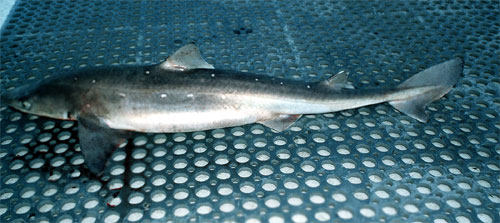
Total landings of spiny dogfish peaked in 1974 at 27,400 metric tonnes, followed by a sharp decline, stabilizing at 5,900 mt during the 1980s. In the 1990s, landings rose dramatically, with over 28,000 mt taken in 1996. Spiny dogfish are caught primarily with otter trawls and sink gill nets. This species is used in the popular British dish “fish and chips” as well as marketed for its oil and as fish meal. This species can cause tremendous damage when entangled in commercial nets.
Danger to Humans
In general, the spiny dogfish poses little if any threat to humans. As the English common name “spiny dogfish” alludes to, this species has spines on the dorsal fins that can result in nasty wounds if not handled carefully. The dogfish uses these spines to defend itself, curling in a bow and striking at any threatening predator.
Conservation
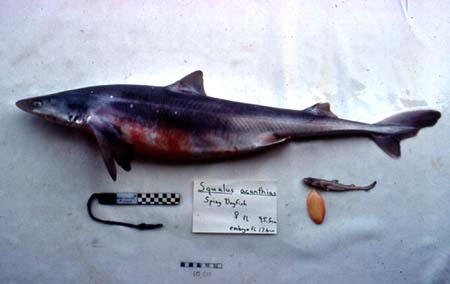
Spiny dogfish are slow to mature and must be managed carefully. This species is extremely vulnerable to over fishing and are currently on the brink of collapse. They have a long gestation period, produce small litters of pups, and are slow growing. Commercial fishermen target the mature females because they grow to larger sizes than males. Females don’t reach sexual maturity until 12 years of age, giving birth to approximately 6 pups after a 2-year gestation period. The dogfish fishery increased dramatically in the U.S. during the 1990s, resulting in a 75% reduction in mature females, leading to record low numbers of pups over the past seven years.
In 2001, the Atlantic States Marine Fisheries Commission (ASMFC) voted to extend an emergency action that closes state waters to fishing for the vulnerable spiny dogfish. This was in response to heavy fishing that devastated dogfish populations during the 1990s. In late 2000, a fishery management plan for the spiny dogfish began to be developed, followed by its approval in November 2002. Federal and state recovery plans are currently in place but continually challenged. In mid 2003, the ASMFC held a vote on a motion to lower the spiny dogfish quota to a level supported by scientific data. However, this motion fails to achieve the required two-thirds majority. The National Marine Fisheries Service, with new stock assessment data predicting the collapse of the spiny dogfish population, closed federal waters to dogfish fishing in July 2003.
The National Marine Fisheries Service currently regulates shark fisheries, including the spiny dogfish, in federal waters; setting forth closures when quotas are reached for each shark species group (large coastal sharks, small coastal sharks, and pelagic sharks).
The spiny dogfish is considered as “Vulnerable” by the World Conservation Union (IUCN) due to intense fishing pressure. The IUCN is a global union of states, governmental agencies, and non-governmental organizations in a partnership that assesses the conservation status of species.
> Check the status of the Spiny Dogfish at the IUCN website.
Geographical Distribution
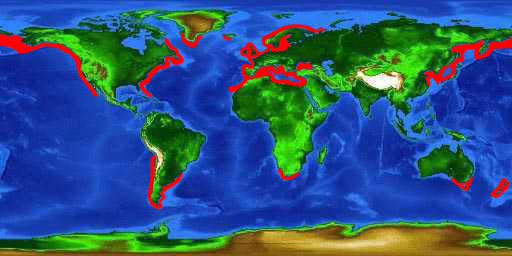
Spiny dogfish are found in the western Atlantic Ocean from Greenland to Argentina and in the eastern Atlantic from Iceland and Murmanski Coast (Russia) to South Africa including the Mediterranean Sea and Black Sea. In the western Pacific Ocean, the spiny dogfish occurs from the Bering Sea to New Zealand while in the eastern Pacific, this species is found from the Bering Sea to Chile.
Habitat
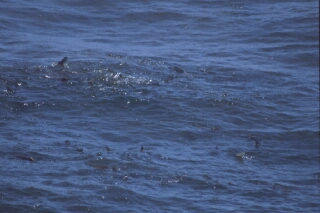
Spiny dogfish are found epibenthically, however they do move through the water column, up to surface water. These dogfish are found in inshore and offshore waters over the continental shelf to depths of 2950 feet (900 m). Although they can tolerate brackish water, spiny dogfish prefer full-strength seawater and do not enter freshwater habitats.
Spiny dogfish swim in large schools with individuals of the same size class staying together as they grow. Schools can consist of either mature large females, medium size mature males or immature females, or of small immature fishes of both sexes. Immature dogfish tend to school offshore while schools of mature females are often observed inshore.
Dogfish are a highly migratory species. Found primarily north of Cape Cod in the summer, they move south to Long Island in the fall and as far south as North Carolina in the winter. During the spring, they begin their migration north, reaching Georges Bank in March and April. They are absent along the coast of Canada and Maine until late June and July.
Distinguishing Characteristics
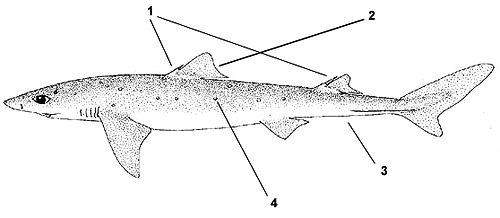
1. Dorsal fins both preceded by a single spine
2. First dorsal fin is obviously larger than second dorsal fin
3. Anal fin is absent
4. Body scattered with small white spots
Biology
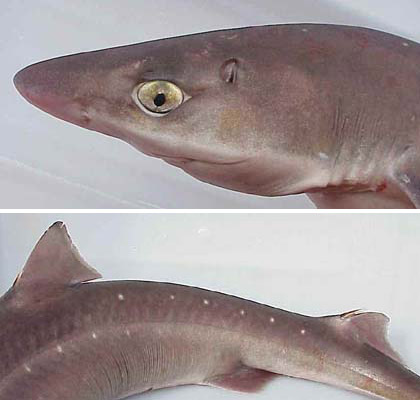
Distinctive Features
The spiny dogfish has a slender, elongate body and a moderately flattened head. The snout is narrow, tapering to a pointed tip. The eyes of this dogfish are moderately large. The first dorsal fin is located about halfway between the pectoral and pelvic fin origins and behind the rear tips of the pectoral fins. The second dorsal fin is about two-thirds the size of the first and is located behind the pelvic fins.
There are sharp dorsal fin spines at the anterior margins of the dorsal fins with the first about half as long and the second nearly as long as the anterior margins of their respective fins. The pectoral fins form nearly perfect equilateral triangles with rounded rear tips and slightly concave rear margins. The pelvic fins are closer to the second dorsal fin than the first dorsal. There are low lateral keels located on the caudal peduncle. There is no notch on the upper caudal lobe and the lower caudal lobe is not well-developed. There is no anal fin on the spiny dogfish.
Coloration
The dorsal surface of the spiny dogfish is slate-colored and may have a brownish cast. There is a lateral row of small white spots along each side from above the pectoral fins to above the pelvic fins. These spots of conspicuous on immature fish, fading with growth until they disappear entirely from some individuals. The edges of the first and second dorsal fins and the caudal fin appear dusky at birth but quickly fade. The ventral surface of the spiny dogfish ranges from pale gray to pure white.

Dentition
The upper and lower teeth are small and similar in shape with oblique points bent toward the outer corners of the mouth. The cusps are deeply notched outward with a single sharp point. These form a nearly continuous cutting edge from one corner of the mouth to the other. There are 28 upper teeth and 22-24 lower teeth in the jaws of the spiny dogfish.
Denticles
Dermal denticles of the spiny dogfish are small and low with three cusps. The central ridge is prominent and the lateral extensions are wing-like in appearance.

Size, Age, and Growth
The average size of the spiny dogfish is 28-39 inches (70-100 cm) with adult males ranging from 24-35 inches (60-90cm) and adult females from 30-42 inches (76-107 cm) in length. The maximum length of males is 39 inches (100 cm) and females 49 inches (124 cm). Mature females reach weights of 7.1-9.9 pounds (3.2-4.5 kg), with a maximum recorded weight of 21.6 pounds (9.8 kg). The all-tackle game fish record is 15.7 pounds (7.14 kg) caught off the coast of Ireland, 1989. Females reach maturity at 12 years of age and from 29.9-30.1 inches (76-78 cm) in length, while most males mature at 6 years and about 23.6 inches (60 cm) in length. They live up to 25-30 years of age.
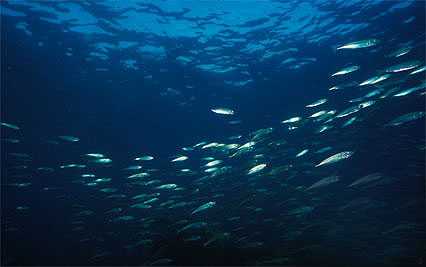
Food Habits
Dogfish have earned a bad reputation among fishermen for their voracious appetites. They are known to drive off commercially caught fish including mackerel and herring, while consuming large numbers of them. Spiny dogfish have been observed biting through nets to get at fishes, releasing many of them in the process. Schooling pelagic fishes make up the majority of the diet of the spiny dogfish. These include herring, menhaden, capelin, sand lance, and mackerel. Other consumed species include wolffish and flatfishes, as well as squid, jellyfish, shrimps, crabs, octopus, and sea cucumbers. It is believed that spiny dogfish rarely feed during the winter months when they stay in deeper waters based upon their very thin appearance in early spring in coastal waters.
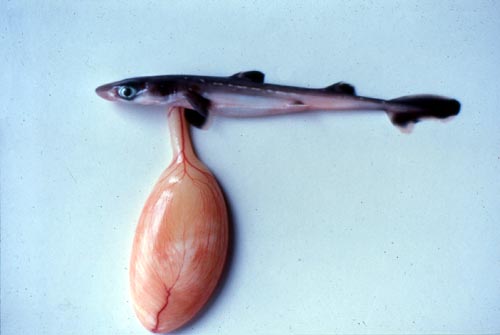
Reproduction
Mating typically occurs in offshore waters with fertilization occurring internally. This is followed by ovoviviparous development. After 4-6 month of development, the membrane providing nourishment to the embryo breaks down. This leaves the yolk-sac to provide nourishment during the remaining 17-19 months of gestation. This species is thought to have the longest gestation period of any vertebrate (up to 24 months). The young are born head-first with cartilaginous sheaths on the spines to protect the mother from injury. Litter sizes average 6-7 but varies between 1 and 15. The newborn pups range from 8-13 inches (20-33 cm) in length.
Predators
Spiny dogfish are been documented in the stomachs of cod, red hake, and goosefish, as well as other spiny dogfish. Larger species of sharks as well as seals and killer whales, although in fewer numbers, also feed on the spiny dogfish.
Firsthand observation of a spiny dogfish giving birth in the wild near Rockport, MA (August 2002).
Taxonomy
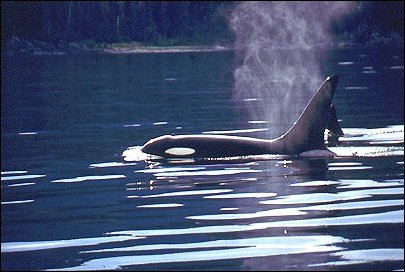
The spiny dogfish was originally described as Squalus acanthias by Karl Linneaus in 1758. However, many synonyms referring to this species have been used in past scientific literature. These include Squalus fernandinusMolina 1782, Acanthias vulgaris Risso 1827, Acanthias americanus Storer 1846, Spinax mediterraneanus Gistel 1848, Squalus sucklii Girard 1855, Squalus suckleyi Girard 1855, Acanthias sucklii Girard 1855, Acanthias linneiMalm 1877, Acanthias lebruni Valliant 1888, Acanthias commun Navarette 1898, Squalus wakiyae Tanaka 1918, Squalus kirki Phillipps 1931, Squalus barbouri Howell-Rivero 1936, and Squalus acanthias africana Myagkov & Kondyurin 1986.The valid genus name Squalus is Latin for “a kind of sea-fish” while the species name acanthias translates as “a prickly thing”, describing the spines found on the dorsal fins of this dogfish.
Prepared by: Cathleen Bester
